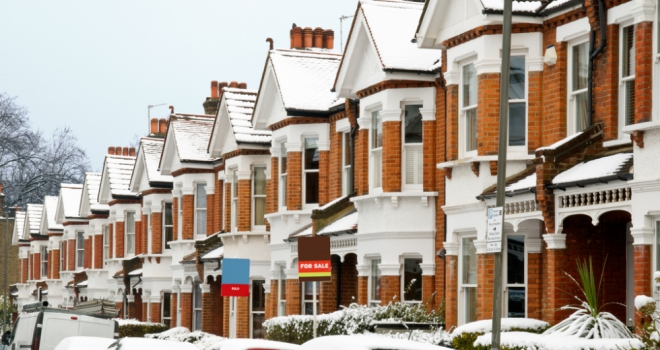House prices fall further 1.5% in December: Halifax
All nations and regions saw annual house price inflation, although the rate of growth has slowed.

"Uncertainties about the extent to which cost of living increases will impact household bills, alongside rising interest rates, is leading to an overall slowing of the market."
The average UK house price fell by 1.5% in December, following a decline of 2.4% in November, according to the latest Halifax house price index.
The annual rate of growth has now dropped to 2.0%, from 4.6%, with the typical UK property costing £281,272.
The rate of annual growth slowed in all nations and regions during December.
On an annual basis, the North East saw the greatest slowdown in growth, with annual house prices rising by 6.5%, compared to 10.5% the prior month.
Eastern England, West Midlands and Wales experienced the smallest falls in growth rate. Those buying in the East of England will now pay an average £337,215 (growth rate 5.5% vs 7.2% in November), while in the West Midlands average properties now cost £250,965 (growth rate 7.3% vs 9.1% in November). The average home in Wales is now £217,547, with annual growth now 6.1%, down from 7.7% the prior month.
Those buying in Scotland will find an average home now costs £200,166, with the second greatest slowdown in the annual growth in the UK, now 3.5%, down from 6.4%.
Properties in Northern Ireland are up 7.1% year-on-year, lower than the 9.1% last month, with average homes now costing £183,825.
The cost of an average home in London in December was £541,239, a growth of 2.9% annually, compared to 5.0% last month.
Kim Kinnaird, director of Halifax Mortgages, said: “In December, the cost of the average UK home was £281,272, a fall on the previous month of -1.5%, with annual growth slowing to 2% (from 4.6%). However, the fall in December was lower than the monthly decline of -2.4% recorded in November, even taking into account seasonal slowdown driven by the festive period.
“As we’ve seen over the past few months, uncertainties about the extent to which cost of living increases will impact household bills, alongside rising interest rates, is leading to an overall slowing of the market.
“The housing market was a mixed picture in 2022. We saw rapid house price growth during the first six months, followed by a plateau in the summer before prices began to fall from September, as the impact of cost of living pressures, coupled with a rising rates environment, began to take effect on household finances and demand.
“These trends need to be viewed in the context of historic prices. The cost of the average home remains high – greater than it was at the start of 2022 and over 11% more than house prices at the beginning of 2021. The first half of last year was a very strong period for sellers, between January 2022 and August 2022, the average cost of a home rose by over £17,000 to £293,992 (growth of +6%), setting a new record high.
“As we enter 2023, the housing market will continue to be impacted by the wider economic environment and, as buyers and sellers remain cautious, we expect there will be a reduction in both supply and demand overall, with house prices forecast to fall around -8% over the course of the year. It’s important to recognise that a drop of 8% would mean the cost of the average property returning to April 2021 prices, which still remains significantly above pre-pandemic levels.”
James Briggs, head of personal finance intermediary sales at Together, commented: “The 1.5% drop in house prices recorded in December suggests it’s going to be a cold January for the housing market. With high mortgage rates and the cost-of-living crisis crunching buyers’ budgets, many buyers are putting property plans on ice for the foreseeable future to prioritise other household expenses.
“Mortgage rates have cooled from their peak last October but remain higher than a lot of buyers can realistically afford in the tougher economic climate, and many are bracing themselves to weather future interest rate rises as the Bank of England takes action to control inflation. Reports that the number of first-time buyers entering the market fell by 9% in 2022 do little to improve market outlook.
“As we face a new winter of discontent, we need specialist lenders now more than ever before. It is only this sector which can offer the flexible criteria individuals need to make their dreams of home ownership a reality and pave the way for a new spring in the housing market.”
Iain McKenzie, CEO of The Guild of Property Professionals, added: “After hitting an all-time high of nearly £300,000 in the summer, house prices have now fallen back below the level they were in March.
“There’s no need to panic, as a readjustment in the market was to be expected following more than two years of inflated house prices.
“Fortunately for sellers, the demand for quality housing is still high, and many areas of the country are still seeing a shortage of stock, which will keep prices buoyant in the months ahead.
“Pessimism over the future of house prices may be misplaced. Employment figures remain strong, and there are signs we may soon see falls in the wholesale fuel prices, which have helped drive up inflation and the cost of living over the past year.
“The effects of the cost-of-living crisis will continue to determine house prices in 2023, as prospective buyers take mortgage affordability into account before signing on the dotted line. Inflation must be brought under control in order to restore confidence in the property market.”

